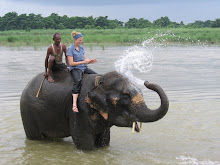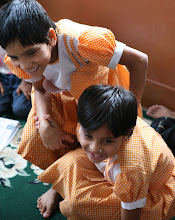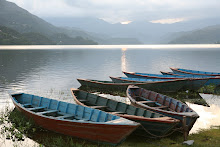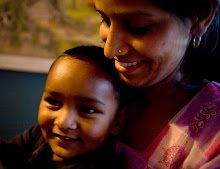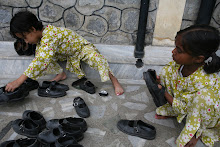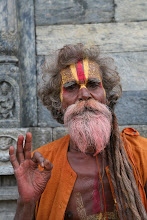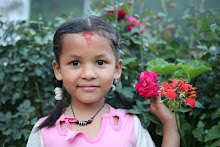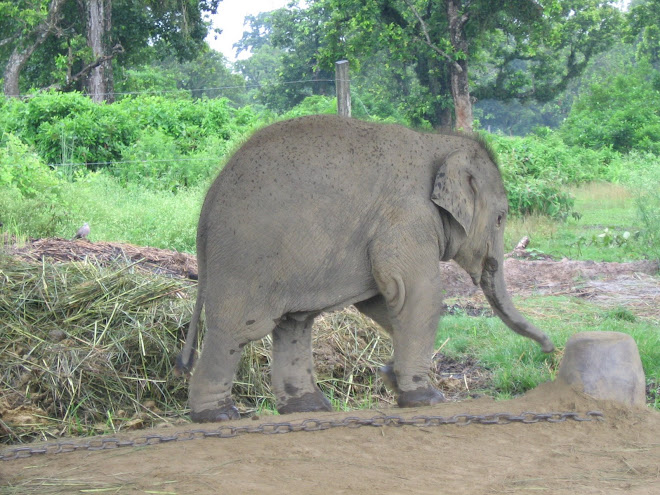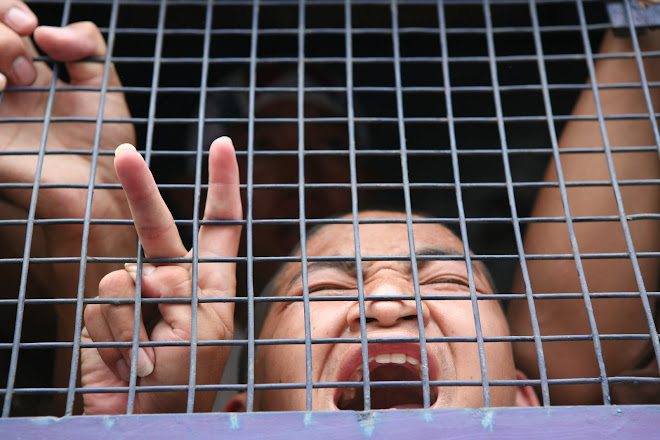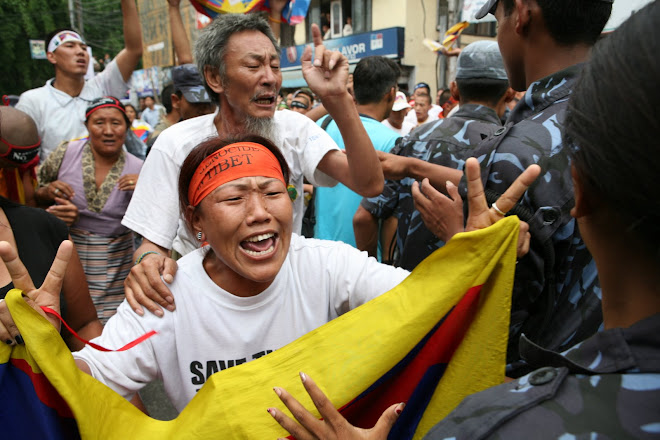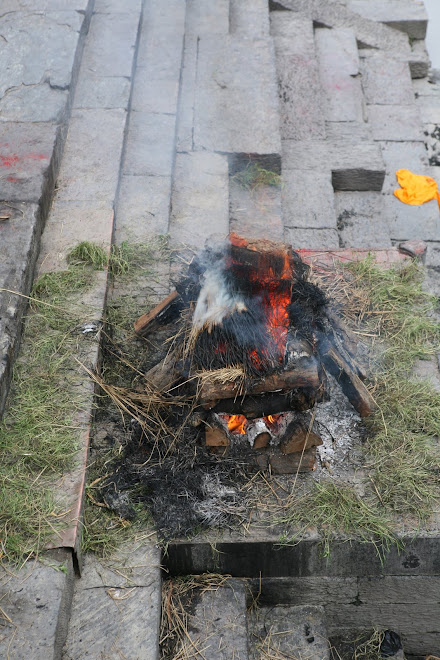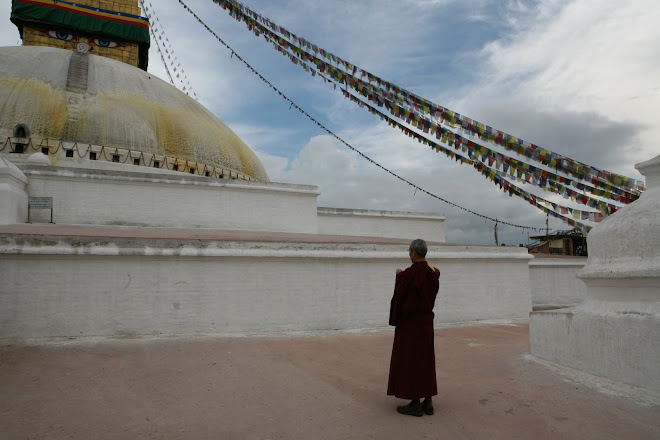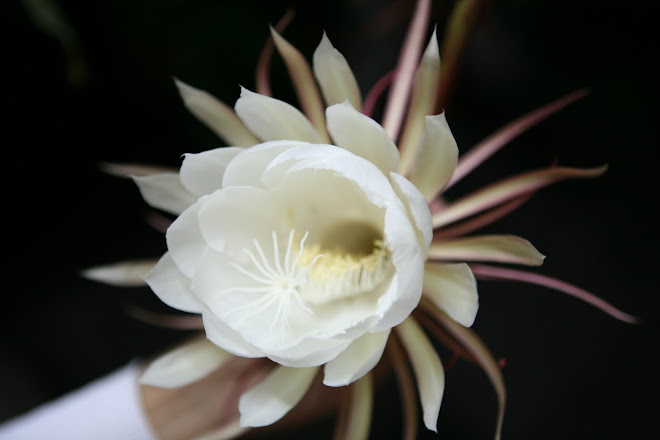Tibet Protester
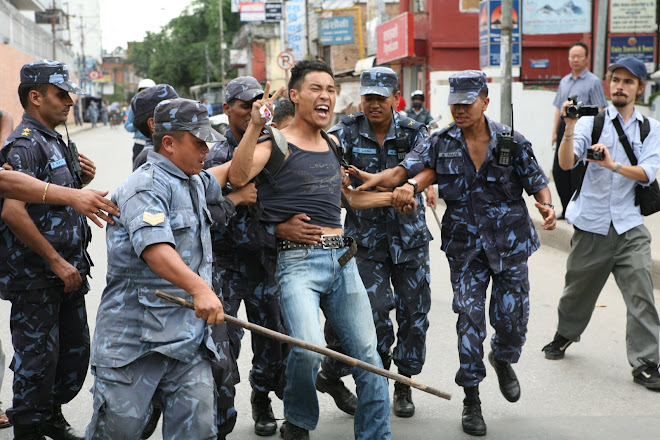
A man is taken away by Nepali police during a Tibetan protest outside of the Chinese Embassy in Kathmandu.
World Peace Pagoda

This is a holy site for Buddhists on top of a hillside over looking the Pokhara Valley, about seven hours west of Kathmandu. It is believed Buddha came to this hilltop to find enlightenment,
Tibetan Flags
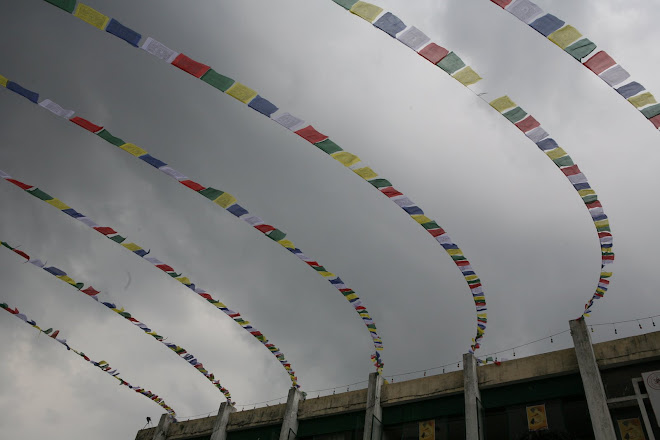
Rows of the flags waved over the film festival on the June 6th. Almost everyday in Kathmandu, Tibetan protesters are arrested outside of the China Embassy.
Wednesday, September 10, 2008
Back to Reality
Monday, July 21, 2008
Rafting and Chitwan National Park
For four days I went to Chitwan, with my teacher's son Brendan, for a jungle experience. We had a blast! Although, according to guide books, we broke every rule possible, some of which are:
1. Don't take a bus anywhere in Nepal (not trying to sound like a hero, but I take at least two buses everyday).
2. Don't go to Nepal in the monsoon season, which is now (too late for that, already survived 8 weeks of the monsoon!)
3. Whatever you do, DO NOT go the Terai area (which is where Chitwan is located) because of (old) political tensions and malaria
4. Forgot to take the malaria pills
But hey, you live and learn, and I'm still doing both! We stayed at a little jungle lodge with good food, all activities and a guide for only $70. We went on two elephant rides, saw one rhino in the wild, along with deer, birds, wild boars, and crocodiles. My favorite part was the elephant bathing in the Rapti River. The most depressing part was going to the elephant breeding center, where they have to chain the babies up so they don't run off into the jungle. The baby elephants could have possibly been the cutest things I've ever laid eyes on. But their eyes glazed over, just wanting to be by there mom's was heart wrenching.
It also really bothered me how the elephants are treated (hit with wooden and metal sticks if they don't listen or go fast...it's an elephant, they don't walk fast!!) Is this eco-tourism or animal maltreatment?! (I feel an op-ed piece brewing inside me...) I may be a little backwards when this bothers me more than poor, hungry village families, but I can't help it.
Tibetan Protest
I got there just as it started and there were about 100 Tibetan protesters in the streets marching, shouting and waving flags and banners. Pretty peaceful I would say. Apparently not to Nepali cops; this does not fly with the them. Immediately protesters were detained and thrown into awaiting trucks, taking them to local jails. I have never seen people so passionate, and with so much conviction as these Tibetans. Right before my eyes, people were being punched, pushed and kicked to the ground. I even saw one man get kicked in the stomach and head, after he was unconscious. This is when I stepped in and tried to help him.
You have to be a person before a photographer sometimes. I could tell he could have been killed if it was to keep going. I got a group of other protesters and helped them drag his limp body to the sidewalk. I was punched by cops and told to stop helping him and leave the scene. I said, "This man could die!" and was pushed some more by that response. My first aid and WFR kicking in, I made sure he was still breathing then tried to wake him up. People were screaming and crying that he was dead. They dumped cold water on him and a few minutes later he woke up. Needless to say, I was sure there were many internal injuries, just looking from his bruised and battered stomach. I have a picture of this man's head out cold on the cement with a cops boot next to it, right after he kicked him one last time.
Meanwhile, nothing stopped as more and more people were hauled off into more awaiting jail trucks. The protesters would not stop the chant "Free Tibet!" even as they were thrown into the trucks. It didn't matter if it was women or old people, they were treated just as poorly as the rest. Absolutely no human rights in this process. Bamboo sticks flying in the air, coming down with a snap onto limbs and skin.
After about forty five minutes of hell, it was all over, streets cleared, photographers scanning their photos, other tourists continuing on their way, storekeepers back in their shops.
However, I was shaken up for days to come.
Wednesday, June 25, 2008
OSHO Commune
I was welcomed into the group right away, even though I was just staying for one night. I had to buy maroon meditation robes, because you aren't allowed to wear regular street clothes on the Ashram's premises. When we got there, which we barely did as my friend's motorcycle was almost out of gas due to the the petrol shortage, it was time for dinner. On the welcoming sign it says, "NO DRINKING, NO SMOKING AND NO NON-VEG'S ALLOWED." In Nepal, they say non-veg if you are a meat eater, unlike how we usually say vegetarian. After dinner, it was time for evening meditation, which is done in white robes. So there I am, the only red robed, white girl in the room. It turns out this meditation is really a big dance party. Music thumped from the meditation hall, blaring Nepali drums, shouts, and beats of all kinds. I got my groove on, even alone in my dark robes. It was awesome!
Sunday, June 22, 2008
Transportation Strike
I heard someone talking about it say, "After all, this is Nepal."
Friday, June 20, 2008
Pokin' around in Pokhara
I got to write a tourism travel log for the KTM Post while I traveled to Pokhara, Nepal. It is the second largest tourist town in Nepal and I can see why. It is set on the second largest lake in Nepal called the Phewa Tal, with fun shops and restaurants and most importantly CLEAN AIR! The backdrop is the Annapurna Mountain Range, the second largest in the country after Everest of course, which gets the trekkers coming to the town. You see either hippies, trekkers, or do-gooder's for the country, along with natives for the most part.
In order to do a tourism log, I had to be the ultimate tourist. I took a pony trek up the World Peace Pagoda, which was cool; you go through the jungle and then up to the hillside where Buddha apparently found his enlightenment. I felt like a lazy American though, sitting high on a horse, named "King" because he was the biggest on the farm, but I thought he was actually pretty skinny... while leeches sucked at his hooves (without horse shoes :( ... ) and my guides ankles. Ugh. Nice views at the top of the Pokhara Valley though. I tipped the guide way too much probably, but hey I'm a guide and now what its like to take tourists on a river, so maybe its good guide karma?
I also visited a cave called Mahendra Cave, named after an ancient Nepali king. It was cool, you walk inside about 100 yards into the earth, but that's about it. I took a rain check on the bat cave nearby though.
One of the best times I had while in Pokhara was visiting an orphanage called the Kopila House, or Sam's House. I met a guy on the plane over here, from Minnesota no less, who started a children's house with his wife a few years ago. This visit inspired me to begin a personal project on Nepal's orphanages and their usually poor conditions. This one however was super nice. There are about 20 kids, they all have their own beds with clean sheets and are probably more responsible and mature than your average college kid. I was pretty happy with some of the photos I made. They do all their own chores, help cook/clean etc. I was beyond impressed; unfortunately this is a rare case in Nepal. More to come on that project later.
Besides shopping, eating, and getting over a nasty cold, I also went to a Yoga and Meditation retreat center for a day/night. A couple owns this resort, that is still being built called the Sadhana Yoga Center (if you're ever in the area ;) They offer yoga three times a day, along with meditation and chanting and serve all organic vegetarian meals from food grown in their garden. You also get a mud or steam bath, yogic body clensings, which cured my head cold. All this is included with your room for $20. Cheap cheap.
I took a bus there and back which was an interesting experience in itself. Imagine the Greyhound, but Nepali style. Then picture that on a bumpy road, over a 400 ft river gorge below, a single lane highway passing other buses and trucks. Sound like fun yet? Then add in a traffic jam that took 3 hours to go about a mile.
ps : THERE IS NOTHING BETTER THAN TRAVEL COUNTING AS WORK OR INTERNSHIP HOURS!!!
Tuesday, June 10, 2008
Temples in Nepal
I went to the Pashupati Temple, which is the holiest place in the world for Hindus. You are greeted by a 250 rupee charge if you have white skin like me, and lots of monkeys. A tour guide quickly comes up to you, eager to take you around, for a charge of at least 500 rupees. I let him, because I knew I wouldn't get as much out of the experience if I wasn't told about the history of the place.
It is a large compound made up of statues and temples thousands of years old. The Kamma Sutra temple is there, where human sacrifices used to be preformed, and now animals are still sacrificed there. Some intresting engravings and statues, if you know what I mean... This temple is also the place where people are creamated, or rather burned under a pile of straw outside. I saw about three bodies being burned with families watching their loved ones turn to ash. It was very intense. I didn't want to take photos up close, out of respect for the families, but took some from viewpoints across the river, where the bodies are first cleansed before being burned. I never thought I would know the smell of burning flesh, but now I do. You can't go into the actual temple unless you are Hindu, but I was thrilled just to see the outside.
There are holy men who cover themselves in the dead's ashes and live in the many smaller temples on the compound. Their dreadlocks alone were older than I am, some growing their hair for more than 25 years. They have devoted their lives to their gods, and are gauked at by tourists like me. They wanted me to pay them to take their picture, which I did, because hey, it was less than a dollar, and these guys need to eat somehow.
After walking around everywhere there, seeing the hermit caves, and the golden bull, my tour guide took me on the half an hour walk to the Bouda Stuppa, which is one of the holiest places in the world for Buddhists. The Budda's eyes look over the area and look like they are staring right at you. When I got there, I left my tour guide, pay him off and entered in my myself.
You walk in the gate and in the middle is the Stuppa, which is a huge circular temple. You can walk around the outside, but also cannot enter in it. Surrounding it were many shops, restaurants, alleys etc.; it reminded me of a Little Tibet, not that I have seen the real one, but anyway... Many Tibetan monks and flags surrounded the temple, people worshipping and spinning the prayer wheels on the entrance gate. I walked around the loop a few times, did some shopping and caught the bus for a long ride back to my neighborhood.
It was a wonderfully, culture-enriching afternoon, for only about $30 dollars (including wine and groceries for dinner). Gotta love Nepal.
Wednesday, June 4, 2008
Go with your gut
We drove about five minutes, to the main, and one of the only stop lights in Ktm, running the red light and weaving through cars, motorbikes and buses. I had been waiting for what was about to happen next for the entire week I have been in Nepal --- an accident. We t-boned a motorbiker directly in his side. I screamed, hit my head on the seat in front of me (this is why I ride in the back and not front, for a seat is better than a windshield) and yelled at the cabby. He yelled back at me and I told him to stop and see if the person was okay. No time for that in Nepal...
Between holding my breath as we past trucks blowing out the blackest smoke/smog/pollution you have ever seen, I wondered if the person we had hit was alright. He didn't fly off the bike, but looked shaken up --- I was too.
Finally after the meter reached 110 rupees, I told him to "Rokeeno!" or "Stop!" and tipped him 2 small rupees, and walked the rest of the way to the office. (F*** that guy I thought to myself!)
On a lighter note, here is my third clip:
State of art education in Nepal: Peaceful protest through art for higher studies
By Tess McEnroe
Hitman Gurung, an art student at the college, created and directed the piece called “Art. Bridge. Education.” The protest was through art, for art education, and to show the struggle these art students have when they enter the workforce.
“By doing so, perhaps we'll have a practical solution to our problem, and a study can carry on with his study,” said Gurung.
The standard to be hired in the art industry is having at least a four-year program degree, yet this college only has a three-year program. As a result, it is difficult for the students to find employment once they have completed the program. Since there are few proper facilities for a Master's Degree program in Nepal, students are often forced to study abroad to further their art education.
“These students can't go anywhere else after they graduate because there is no Master's Degree available,” said Madan Chitrakar, a temporary faculty member and art writer at the college.
Gurung's piece included about 30 fellow students dressed in smocks, with messages on their backs reading, for example, “This is our future,” and “Can you see me?” Other students and citizens gathered around each of the models writing messages in Nepali and English on their arms, saying, “Let the creators be creative,” and “We want M.F.A. [Master's of Fine Arts] in Nepal,” to name a few.
Both the students and teachers believe that since Nepal has a widely known and respected traditional and folk art community, it is only right to be able to further their study and contribute to the international contemporary art scene.
Tuesday, June 3, 2008
"Is no problem, is fine"
Nepalis are pretty simple people. This may stem from their mostly Hindi and Buddist religions, but I am still trying to figure out the root of this idea. Although I really do like that mentality, it is slightly frusterating that everyone runs on their own schedule.
Yes, it is a large cultural difference than us, high-strung, multi-tasking, hyper-tensive Americans. For example, it has taken over 50 hours for my press ID badge to be made. You have to track the person down in charge of making them, and remind them three times, and then maybe it may be done by 5pm today as promised. I have been lucky that on my assignments so far, I haven't needed one, but I cannot imagine not have a credential if I was sent to cover, for instance, a Maoist Party meeting, or the exit of the King from his royal palace.
I was told before I came here, and now I understand first hand, that Nepalis are kind, almost too kind for their and my own good sometimes. There is often too much trust in strangers. Quite a difference from the sometimes guarded personalities we encounter at home in the states. We in America are raised to be very aware and cautious of people we don't know for the most part. I know that is a big hunch, and a possible stereotype, but I think you get my drift.
2nd assignment
Cartooning class for deaf students
by Tess McEnroe
National Campus Principal, Sarah Giri, a sign language specialist, interpreted for the deaf students as guest lecturer and cartoonist, Yogesh Khapangi, spoke in Nepali. The goal of the class was to give the deaf community an example of a vocational option, and help them see art in different ways.
"We organized this program as a step towards social inclusion for deaf students in academics," said Giri.
The deaf culture is a visual one, according to Giri, and forms of art such as painting and cartooning, for example, give the deaf more advantages in the visual communication world.
Khapangi specializes in cartoons, graphics and illustrations and is also the Vice President of Cartoonists' Club of Nepal (CCON). Giri invited him to lecture because he can be a role model for deaf students and the deaf community. During his hour and a half lecture, Khapangi displayed the basics of how to draw a human figure, and when to use the proper materials, such as sketching pencils and markers.
The students participated, interacted, and got to practice cartooning and drawing techniques with the pencils and sketch books that they were allowed to keep.
"This is not for entertainment, the deaf have enriched my life, so I am trying to enrich theirs," concluded Giri.
Monday, June 2, 2008
My First Assigment: 1st International Mt. Everest Day
Beautiful waste from Everest
by Tess McEnroe
The exhibit was sponsored by a variety of groups including the Rotary Club Nepal, to put the waste to good use in forms of sculpture that will be constructed by a group of 13 artists by Friday. Sunday was the start of the project and during this week, the artists will use the so-called “waste” to be made into works of art. This project has been awaiting this exhibit since 2005.
Gopal Sunder Lal Kakshapati, the President of the Rotary Club said, “We wanted to do something for the waste and make an eye-opener for people. There is no value in keeping all of this in a room, so it was my idea to turn the waste into something beautiful.”
Chief guests of honor at the opening ceremony included Kali Das Shrestha, a well-known Nepali fine artist, the President of the Nepal Mountaineering Association, Ang Tsering Sherpa and Mahabbur Rehman from Bangladesh.
During this week, the Rotary Club will decide whether to sell the final sculptures, or put them in museums, possibly in Pokhara. The final cost of getting the “waste,” down from the summit will be about $200,000. The artists' materials included everything from metal scraps from a helicopter crash, to combs and shoes, brought down to the Everest base camp.
Saturday, May 31, 2008
First Few Days
For those who may not know, I am doing my photojournalism internship at the Kathmandu Post in Kathmandu, Nepal for eight weeks. The paper is printed in English and a Nepali version called Kantipur. I will be working as a staff photographer and writer for the City Post section of the paper mostly. Google the Post if you like and I will also try to post my work on here.
You must also know some background information on Nepal's government status now. After 240 years of monarchy, the country is transforming into a republic before my eyes. I still cannot believe I will be one of the lucky journalists to be covering such a crucial and exciting time in Nepali history. In fact, the day I arrived was the first official day of the republic, and the whole country was on holiday, and the next day the king was told to leave his palace. The government is still very unstable and still in the works. The Maoists, or the Communist Party believe they have control, while about 30 other parties disagree.
After over 30 hours on an airplane, including four layovers, having my luggage lost, and getting over jet lag, I love it here so far. Within my first five minutes in the cab ride from the airport to a little hotel in the tourist district of Thamel, I saw naked children being bathed on the sidewalk, cows and goats chewing their cud in the middle of the street, monkeys jumping from tree to tree, and people and garbage everywhere you look. Although Kathmandu is filthy and extremely polluted, I found the people to be some of the hardest working I have ever seen.
The first advice, and some of the best I have gotten in my entire life is: "Be simple, think simple, and things will work themselves out." Rajendra Acharya told me this. He is the director of Nepali Television (a big job) and a graduate of U of MT's School of Journalism's Master's Program. I have been staying with him and his wonderful family these first few days, and will be for about another week I think. I visited his TV station the other day and watched the news being broadcasted first in Nepali and then in English.
Time is not an issue here. It is like "river time" to me, so I can get used to it. There is barely any punctuality. You never know when the power will be shut off at night for up to 16 hours. It is practically a death wish if you want to cross a street here as well. If you have ever ridden in a Mexican cab, multiply that by 50 and then you will maybe understand how Nepali's drive. These are normal things in Nepal.
The food is obviously also quite different than what a white girl is used to. I am sticking to potatoes, or "alloo," rice and cooked veggies -- no meat (which is goat, buffalo and chicken mostly). I bought Nepali dictionary before I came, but it hasn't been nearly as useful as hearing the language first hand, and I have already learned about ten words and few phrases. Rajendra's sweet daughter, Sanskriti, gives me a quiz everyday, after learning my new "word of the day," and I do the same for her in English. It's a good system. Hopefully by the end of eight weeks I will be able to get around pretty well.
Today is my first day the Post and I am waiting for my boss to get here. I don't start work until noon, which is an adjustment. I am sitting here wondering what my first assignment will be....
